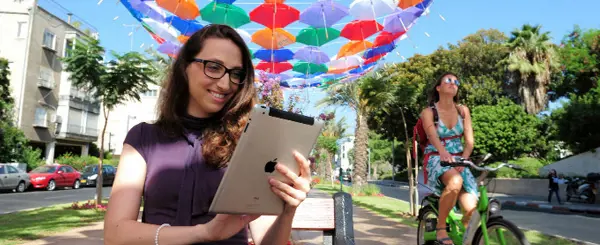Tel Aviv is a Smart City.
[1] Built on the dunes of Mandate Palestine’s Mediterranean coast to the north of Jaffa, according to Patrick Geddes’s urban plan, it was initially planned as a Jewish suburb to Jaffa. Within twenty years of its existence, the neighbourhood was forced to adapt to absorb unprecedented waves of immigration of Jews feeling rising pressures in Eastern Europe. Tel Aviv’s growth was necessarily both haphazard and planned, with these characteristics still evident in the city’s built environment. In 2003 the city was inscribed as a UNESCO World Heritage Site, recognised for the historic core’s homogeneity of International Style buildings, and the integrity of Geddes’ urban plan.
As the antithesis of Jerusalem, Tel Aviv is secular and liberal. The economy is prospering, the nightlife is lively, and the café and beach scene is busy. The municipal authorities encourage creativity, education and social and economic prosperity.
Underpinning each of these aims is a municipal agenda to achieve the 11th UN Sustainable Development Goal: Sustainable Cities and Communities. The City’s planning department aims to make Tel Aviv inclusive, safe, resilient and sustainable through long term investment in local communities.
By adopting Smart City Principles, Tel Aviv’s municipality connects with its residents through technological advances. Residents have access to free Wi-Fi throughout the city, encouraging inhabitants to gain autonomy in managing and participating in internal municipal decisions. iView (the municipal GIS) enables residents, tourists and professionals to comment on the urban environment, fostering transparency, accessibility and active citizen engagement. Through DigiTel, a live app-based service, planning decisions can be observed and logged, present and future construction and renovation works are indicated as alerts, and citizens are offered information on local cultural events. That 60% of Tel Aviv’s residents are registered with the service is testament to the success of the municipality in changing the way residents engage with the urban environment.
As a Smart City, such strong civic involvement has the potential to transform the ways that heritage values and planning – too often seen as distant and unengaging – are communicated and experienced by residents.
While the ‘Smart London’ Plan
[2] strives to engage citizens, enable growth and work with businesses, there is little mention of ways in which the Plan envisages communicating heritage values to residents through new technologies. Perhaps London needs to take a lesson from Tel Aviv’s successes to promote ways in which internet and mobile communication can transform conventional interaction with cultural heritage. By using smartphones to create a streamlined network, civic interaction with historical and environmental resources and the urban environment would be apparent. Rather than having apps and email notifications specific only to museums, shops, and locations, if London were to take a holistic approach, users (residents, industry professionals, academics and students) could post and share comments and reviews on the built environment. This would strengthen wider, inclusive and sustainable civic participation and appreciation of London’s rich cultural heritage, changing the way individuals interact with the built environment.
Stella Fox is a Heritage Consultant based in our London office. She recently completed a research project on the twentieth century evolution of Tel Aviv.
[1] A Smart City is an urban area that uses different types of electronic data collection sensors to supply information and to manage its assets and resources efficiently
[2] This is a Mayoral initiative which seeks to promote digital collaboration between the Mayor and the London Boroughs

